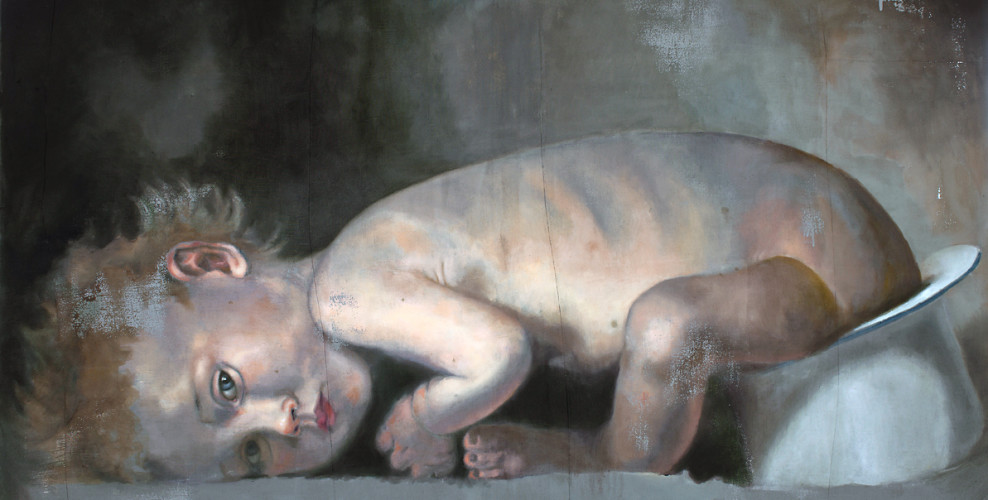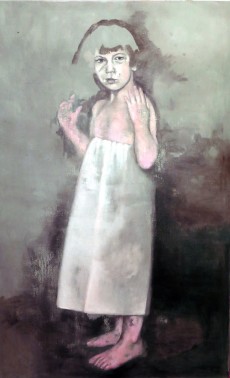 International fine artist Suzanne Levesque is gaining attention for her intriguing large-scale oil paintings which merge Classical style with an unorthodox conceptualization of childhood.
International fine artist Suzanne Levesque is gaining attention for her intriguing large-scale oil paintings which merge Classical style with an unorthodox conceptualization of childhood.
In depicting her fictional, gender-and-age vague children – blank slates by which to explore our own grown-up projections – the artist’s strokes are as exacting as a surgeon’s scalpel.
Unsurprisingly, Levesque is partly inspired by the overlap she perceives between forensic medicine and art – each discipline, at its core, ferreting out convenient lies in the pursuit of hidden truths.
Between European shows and a galvanizing relocation to NYC, Levesque spoke with Kid-In about our idealized constructs of youth, our very first-firsts, and about finally getting being a kid.
So, you’re a New Yorker now?
Yes, I’ve lived along the East Coast on and off, and I’ve always wanted to spend more time in NYC. Not just because of the art scene, but also to be closer to my extended family.
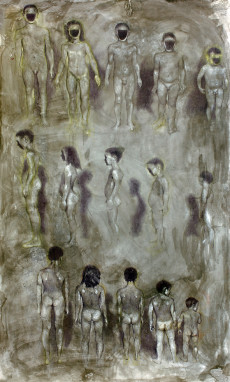 Where did you grow up?
Where did you grow up?
I was born in Luxembourg and grew up going back and forth between New London, Connecticut and Paderborn, Germany.
What was the role of art in your life as a child?
My initial leanings toward art have much to do with my parents who are both musicians. They were encouraging of my creativity. As an introverted child, I was fond of repetition: from reading to swinging on a swing for five hours. In a similar and regimented way, I utilized drawing to create my own world – an environment that felt safe to me. It was a way to communicate with myself.
My father found a strict but kind Ukrainian artist who became my first tutor. I learned from him the love and relentless dedication it takes to realistically pursue fine art as a career.
The school I went to hardly supported these leanings. I felt a lack of support there also from my peers. Fortunately, my grandmother – a painter living in New York – and her involvement in the arts forged a way for me to pursue art with conviction.
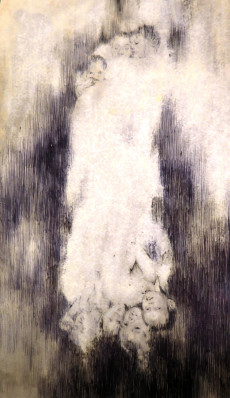 What kind of art did you like or like making, as a kid?
What kind of art did you like or like making, as a kid?
I enjoyed drawing faces as a child. I tried all kinds of subjects, both abstract and representative, but the figure always serves the most authentic way of communicating my ideas. Other subjects seem a metaphor or stand in for people.
When I was about nine I happened to sit in on a slide show about Sally Mann. That really spoke to me because she showed children in an honest way.
Where did you study art?
I went to art school in Hamburg, Germany (HAW) and Baltimore, MD (MICA).
Who were other mentors in discovering art and becoming an artist
I had the privilege of studying under Hinnerk Bodendieck in Hamburg. He sparked my passion for painting. I started out painting fast plein air snapshots of my surroundings. I then went onto painting hospitals during operations and cadavers at the morgue. I am extremely interested in 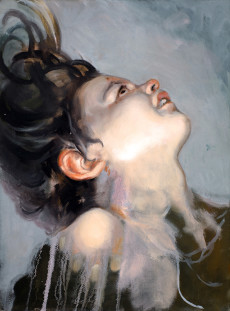 the overlap between medicine and art. For me they go hand in hand; Both focus on the fleetingness of existence. Always looking to heal by finding the cause instead of the symptom. So I see my subjects as specimens in a way.
the overlap between medicine and art. For me they go hand in hand; Both focus on the fleetingness of existence. Always looking to heal by finding the cause instead of the symptom. So I see my subjects as specimens in a way.
I also learned a lot from Nir Alon, an Israeli installation artist who imbued in me a new perspective on painting.
After school I shared a studio with the young artist Jen Yu. Her input was invaluable in developing my artistic foundation. I felt her ideas resonated with my own.
Is art therapeutic?
Yes, especially the act of painting or drawing. I guess if you get so excited about something it has to be therapeutic. But sometimes remedies have side effects; when I spend too much time alone in the studio I start getting a little odd. I should probably step out and get away from my paintings more often.
 Your paintings are quite Classical in their style, yet in content they are rather modern or unique. Who are some of your influences?
Your paintings are quite Classical in their style, yet in content they are rather modern or unique. Who are some of your influences?
Sometimes I come across people who paint in the way I would have wanted to paint. This gives me such a rush of excitement. I feel legitimized in what I do when I see others make similar work. That said I am influenced by: John Singer Sargent, Louise Bourgeois, Michael Borremans, Paula Moderson Becker and Justin Mortimer. But, also by my own grandmother – her paintings were such a big part of my childhood and helped inform my aesthetic.
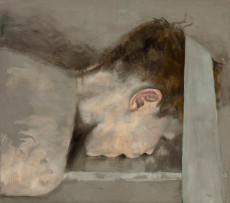 Why do you focus on children currently?
Why do you focus on children currently?
I use depictions of children as abstractions. Their age is intangible and they are freed from gender constraints. They are, in a way, clean slates onto which one can project one’s perceptions.
Children are also intensely vulnerable. I want the viewer to question their own gaze and their interaction with my images.
Your vulnerable subjects are quite massive in scale.
A lot of times I paint life size or even larger-than-life, to both counteract and heighten their vulnerability. They are vulnerable children – towering over you! But they are not overbearing. I paint them in a whisper, with light washes of color or fine lines of ballpoint pen clustered together.
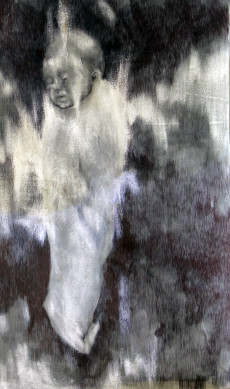 What are some societal views on childhood that you deconstruct or challenge with your paintings?
What are some societal views on childhood that you deconstruct or challenge with your paintings?
I don’t believe childhood should be glorified or romanticized. It doesn’t benefit children, adults, or anyone in between. I think children should be taken seriously. We don’t do children justice by thinking images of them should just be cheerful and bright. Childhood is terrifying – children actually believe there are monsters under the bed. Imagine going to bed every night with a monster lurking. It is also a very absurd time. I remember everything seemed magical; my Dad can drive a car! I saw a man take out his teeth – so I believed I could too. I believed everything. Aliens? Sure! I was convinced Santa and God could hear my every thought. I used to think they watched me in the bathroom. I was constantly, thoroughly spooked.
This speaks a little to the element, in your paintings, of the grotesque or the disturbing. What is the place of these in childhood, as depicted in your paintings?
The first time in life we experience negative feelings is in childhood. We struggle into being and are then confronted with our first fears, first shame, and first loss. The first of anything can be the most disturbing.
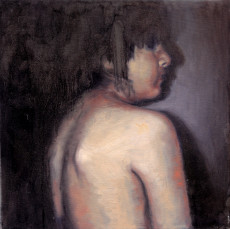 And, before you learn to verbalize and differentiate your feelings about things, these emotions are a confusing concoction of reactions. I remember thinking sadness felt like thirst and wondered if they might be the same thing.
And, before you learn to verbalize and differentiate your feelings about things, these emotions are a confusing concoction of reactions. I remember thinking sadness felt like thirst and wondered if they might be the same thing.
Children can feel powerless. They live in a seemingly lawless society within which bigger kids win, cuter kids are more popular, and talking to adults is difficult.
Using child models for such counterintuitive depictions of childhood could be tricky for various reasons. Who are your models?
I usually use myself as a model. Sometimes I also appropriate found images. Usually there is a leg, mouth, or general position that I have taken from my own poses. My children should be somewhat neutral in their origin. I do not want to use real children, as it is not about a character’s personal narrative. It is fiction without being narrative. I thereby 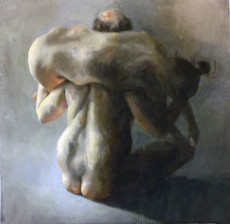 avoid the restraints that come with the implied morality, i.e., exploiting children – although my images are never gory or pornographic in any way.
avoid the restraints that come with the implied morality, i.e., exploiting children – although my images are never gory or pornographic in any way.
My work wants to speak to the child that the adult remembers, not another, actual child. In those terms my work isn’t about childhood at all; I depict children in order to strip away adults’ preconceived notions of gender, age, and race. One cares for children but one also projects into them. I paint these unifying creatures as a clean slate.
In this light: are there any real scenarios or stories behind the images?
Stories have an implied outcome, forming a limited narrative. In a sense they are convenient lies that help us make sense of a series of moments that are too complex for the human mind. The subtlety of implication, in my work, is much more powerful.
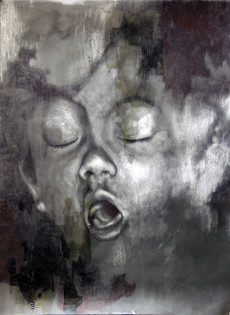 What is your artistic process start to finish?
What is your artistic process start to finish?
Usually I am fixated on something small. For instance, now I am obsessed with gap teeth and loose tights. These themes come and go and pop up in different forms.
I decide on a rough idea of how my picture is going to look. Then I decide on the size. Then I start mapping out the image on the primed ground.
I usually start directly with the medium I am working with, since I don’t believe in making preliminary sketches. Things don’t necessarily transpose well into different scales and, more importantly, it takes away from the immediacy.
The fun part is: never really knowing how something will turn out. I like keeping it fresh, especially when working with oil paints. The more unforgiving and immediate the medium the more tantalizing it is to work with. Oil paints are so sticky and mushy and it gives me the heebie-jeebies to see canvases suffocated with superfluous mounds and blobs of paint. I want to paint with oil as if I were working on a big watercolor.
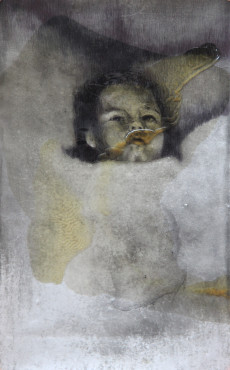 What are you working on now?
What are you working on now?
I love playing with ideas and new materials but it takes a while for something to catch on. Right now I am experimenting with lights, nets, glass and eggs. There are some things I would like to express, but in this case painting may be the wrong medium. I am also looking forward to making some silverpoint drawings in the near future.
Your latest show was in Vienna, how did that go and what is up next?
I am very excited about my last show Kiddo at the Gallery Atelier Xylos in the heart of Vienna. I got to hang my work in a beautiful historic building with brick walls and high arched ceilings. I have a few more shows coming up in Germany and Austria this year – one will be in a small town named Bielefeld at Herr Beinlich Contemporary Fine Art Space.
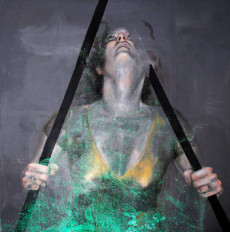 Will your own childhood experience, your narrative, continue to inform the content?
Will your own childhood experience, your narrative, continue to inform the content?
I didn’t really get being a kid when I was young. But now I am more childlike than I ever was and I try to nurture that mindset. I guess my experiences color my approach to everything.
To view more of Suzanne leveque’ s work: suzanne-levesque.com
– Larissa Zaharuk

